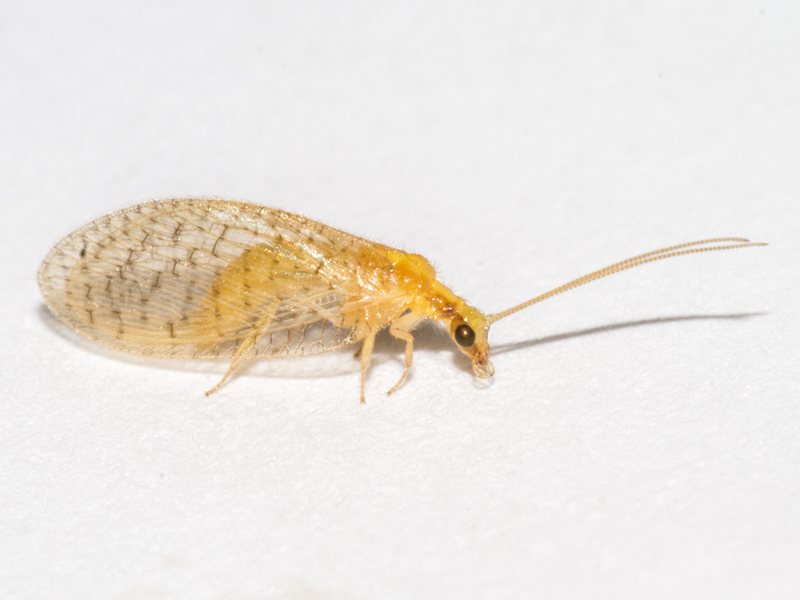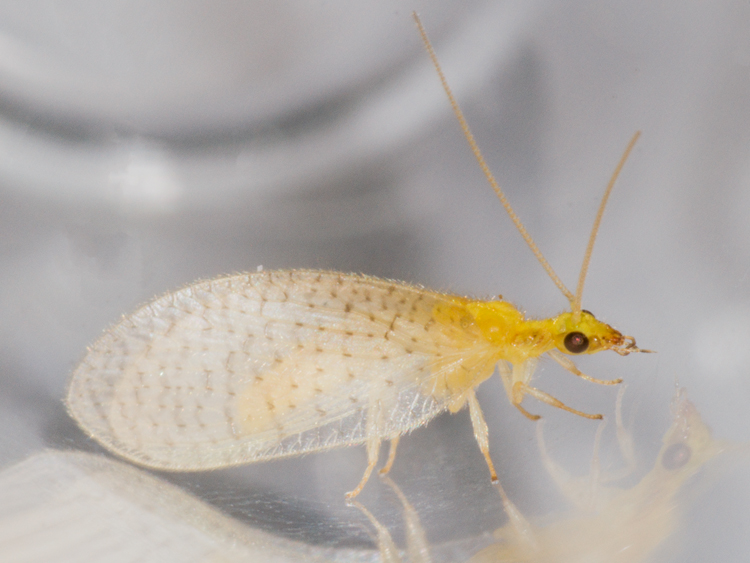Hemerobius micans
A farily common species in Norfolk, flying from April to September, with perhaps a higher proportion of spring records than some of the other Hemerobius (although still peaking in summer).
The presence of a recurrent humeral vein and 3-4 branches to the radial vein helps separate Hemerobius from Psectra and Micromus, and the position of veing RMCV (inside the fork of vein M) helps to rule out Wesmaelius. However, note that vein RMCV is often unpigmented in Hemerobius so you may need to look really carefully for this and it might not show up in photos.
This one of our least-marked Hemerobius with relatively uniform plain wings and the identification will often be suspected based on this quite quickly. However, some Hemerobius lutescens can be very similar and care should be taken to eliminate that. Hemerobius nitidulus differs from micans in the length of the dark dashes along the forewing veins - on nitidulus they are no longer than the width of the vein.
On the following individual vein RMCV was opposite the fork in vein M in one wing, but basal to the fork as usual in the other wing.
, North Elmham, 12-Apr-22 (A) (2).jpg)
, North Elmham, 12-Apr-22 (A) (1).jpg)
, North Elmham, 12-Apr-22 (A) (3).jpg)
, North Elmham, 12-Apr-22 (A) (7).JPG)
, North Elmham, 12-Apr-22 (A) (5).jpg)
, North Elmham, 12-Apr-22 (A) (6).jpg)
, North Elmham, 12-Apr-22 (A) (8).jpg)
male Hemerobius micans showing both forewings (top-lit and backlit) and abdomen, North Elmham (Norfolk, UK), 12th April 2022
 (2).JPG)
 (3).JPG)
Hemerobius micans showing forewing, North Elmham (Norfolk, UK), 8th June 2021
The abdomen tip isn't described or illustrated in Plant (1997) however it may be helpful if you are struggling to decide between micans and a plain lutescens. The abdomen tip of the male at least differs significantly from lutescens.
, North Elmham, 27-Aug-20 (A) (1).jpg)
, North Elmham, 27-Aug-20 (A) (2).JPG)
male Hemerobius micans showing cleared abdomen tip, North Elmham (Norfolk, UK), 27th August 2020
This individual showed a dark crossvein MCCV with a small area of dark shading on the adjacent wing membrane, on both wings. This causes it to mis-key using Plant (1997) but you would end up with a dead-end. I was pretty confident it would nevertheless be micans based on its general appearance, but the addomen tip eliminated any doubt.
, Dillington Carr, 1-May-22 (A) (1).jpg)
, Dillington Carr, 1-May-22 (A) (5).jpg)
, Dillington Carr, 1-May-22 (A) (3).jpg)
, Dillington Carr, 1-May-22 (A) (4).jpg)
, Dillington Carr, 1-May-22 (A) (2).jpg)
male Hemerobius micans showing abdomen tip, right forewing (whole and close-up of base) and left forewing area around vein MCCV, Wendling Beck Environment Project (Norfolk, UK), 1st May 2022
Here is another which clearly has a darkened vein MCCV and slight but definite clouding on the membrane either side of this vein.
, Beetley Meadows, 30-May-25 (A) (1).jpg)
, Beetley Meadows, 30-May-25 (A) (2).jpg)
, Beetley Meadows, 30-May-25 (A) (3).jpg)
male Hemerobius micans showing forewings and close-up including area around vein MCCV, Beetley Meadows (Norfolk, UK), 30th May 2025
Again there was a very slight darkening of the membrane immediately surrounding vein MCCV (on one wing at least) and other than the shape of the abdomen tip it would have keyed to Hemerobius lutescens. However the plain but orangey wings were quite unlike Hemerobius lutescens and the abdomen tip confirmed it was micans as suspected from its overall appearance. Note that the upturned point at the very tip of the abdomen is not always easy to see and may need to be looked for carefully.
, North Elmham, 19-Sep-24 (A) (1).jpg)
, North Elmham, 19-Sep-24 (A) (2).jpg)
, North Elmham, 19-Sep-24 (A) (3).jpg)
, North Elmham, 19-Sep-24 (A) (5).jpg)
, North Elmham, 19-Sep-24 (A) (4).jpg)
, North Elmham, 19-Sep-24 (A) (7).jpg)
, North Elmham, 19-Sep-24 (A) (6).jpg)
male Hemerobius micans showing left wings, two close-ups of base of left forewing including vein MCCV, close-up of right forwing vein MCCV and abdomen tip from side, North Elmham (Norfolk, UK), 19th September 2024

Hemerobius micans, North Elmham Cathedral Meadows (Norfolk, UK), 18th July 2018
 (1).jpg)
 (2).jpg)
Hemerobius micans, North Elmham Cathedral Meadows (Norfolk, UK), 28th September 2020
, Cathedral Meadows, 22-May-19.jpg)
female Hemerobius micans, North Elmham Cathedral Meadows (Norfolk, UK), 22nd May 2019
, North Elmham, 11-Jun-20.jpg)
male Hemerobius micans, North Elmham (Norfolk, UK), 11th June 2020
, North Elmham, 26-Jul-19 (A) (2).jpg)
male Hemerobius micans, North Elmham (Norfolk, UK), 26th July 2019

Hemerobius micans, St Mary's churchyard, North Elmham (Norfolk, UK), 8th June 2021
